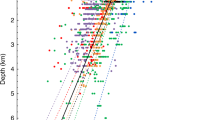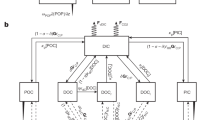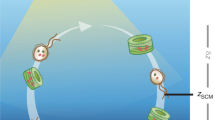Abstract
The sinking of participate organic matter in the ocean links food webs beneath the euphotic zone to surface primary production and is an important pathway for the downward transport of many elements1–3. The flux of particulate organic carbon (POC) is also an important parameter in the global carbon cycle and may be related to long-term changes in atmospheric CO2 4,5. In 1980, Suess6 synthesized existing measurements from sediment trap studies into a model to predict the vertical flux of POC from depth (z) and primary production (PP)6. The Suess model has become the standard for evaluating vertical flux data7, for estimating the annual flux of POC in the ocean8 and for parameterizing ocean carbon cycle models4,5. We present here a new model of the vertical flux of POC and particulate organic nitrogen (PON) from a set of contemporaneous measurements of PP and fluxes made during the VERTEX (Vertical Transport and Exchange) programme in the north-east Pacific. The VERTEX model indicates that PP and vertical fluxes of POC and PON, in the oligotrophic ocean are greater than previously suggested. In addition, the vertical flux of PON from the photic zone represents a measure of the PP that is supported by new nitrogen (new production)9,10. In the north-east Pacific, new production ranged from 13 to 25% of primary production and was positively related to total PP.
This is a preview of subscription content, access via your institution
Access options
Subscribe to this journal
Receive 51 print issues and online access
$199.00 per year
only $3.90 per issue
Buy this article
- Purchase on Springer Link
- Instant access to full article PDF
Prices may be subject to local taxes which are calculated during checkout
Similar content being viewed by others
References
Broecker, W. S. & Peng, T.-H. Tracers in the Sea (Columbia University, Palisades, New York, 1982).
Angel, M. V. in Flows of Materials and Energy in Marine Ecosystems (ed. Fasham, M. J. R.) 475–516 (Plenum, New York, 1984).
Fowler, S. W. & Knauer, G. A. Prog. Oceanogr. 16, 147–194 (1986).
Sarmiento, J. L. & Toggweiler, J. R. Nature 308, 621–624 (1984).
Dymond, J. & Lyle, M. Limnol. Oceanogr. 30, 699–712 (1985).
Suess, E. Nature 288, 260–263 (1980).
Betzer, P. R. et al. Deep Sea Res. 31, 1–11 (1984).
Hargrave, B. T. Ecol. Modell. 30, 229–246 (1985).
Dugdale, R. C. & Goering, J. J. Limnol. Oceanogr. 12, 196–206 (1967).
Eppley, R. W. & Peterson, B. J. Nature 282, 677–680 (1979).
Knauer, G. A., Martin, J. H. & Bruland, K. W. Deep Sea Res. 26, 97–108 (1979).
Knauer, G. A., Martin, J. H. & Karl, D. M. in Global Ocean Flux Study Proc. Workshop 136–150 (National Academy Press, Washington DC, 1984).
Martin, J. H., Knauer, G. A., Karl, D. M. & Broenkow, W. W. Deep Sea Res. (in the press).
Fitzwater, S. E., Knauer, G. A. & Martin, J. H. Limnol. Oceanogr. 27, 544–551 (1982).
Knauer, G. A., Karl, D. M., Martin, J. H. & Hunter, C. N. J. mar. Res. 42, 445–462 (1984).
Knauer, G. A. & Martin, J. H. in Second US-USSR Symposium on Biological Effects of Pollutants on Marine Organisms 145–165 (EPA-600/3-82-034, Washington DC, 1982).
Karl, D. M., Knauer, G. A., Martin, J. H. & Ward, B. B. Nature 309, 54–56 (1984).
Urrére, M. A. & Knauer, G. A. J. plank. Res. 3, 369–387 (1981).
Menzel, D. W. & Ryther, J. D. in Organic Matter in Natural Waters (ed. Hood, D. W.) 31–54 (University of Alaska, 1970).
Shulenberger, E. & Reid, J. L. Deep Sea Res. 28, 901–919 (1981).
Jenkins, W. J. Nature 300, 246–248 (1982).
Platt, T. Deep Sea Res. 31, 1311–1319 (1984).
Jenkins, W. J. & Goldman, J. C. J. mar. Res. 43, 465–491 (1985).
Platt, T. & Harrison, W. G. Nature 318, 55–58 (1986).
Kerr, R. A. Science 232, 1345 (1986).
National Academy of Sciences, Global Ocean Flux Study Proc. Workshop (National Academy Press, Washington DC, 1984).
Sprugel, D. G. Ecology 64, 209–210 (1983).
Author information
Authors and Affiliations
Rights and permissions
About this article
Cite this article
Pace, M., Knauer, G., Karl, D. et al. Primary production, new production and vertical flux in the eastern Pacific Ocean. Nature 325, 803–804 (1987). https://doi.org/10.1038/325803a0
Received:
Accepted:
Issue Date:
DOI: https://doi.org/10.1038/325803a0
This article is cited by
-
Temporal variation of particulate organic carbon flux at the mouth of Tokyo Bay
Journal of Oceanography (2023)
-
Ecosystem Structure and Dynamics in the North Pacific Subtropical Gyre: New Views of an Old Ocean
Ecosystems (2017)
-
Seasonal variability in carbon demand and flux by mesozooplankton communities at subarctic and subtropical sites in the western North Pacific Ocean
Journal of Oceanography (2016)
-
Rapid carbonate depositional changes following the Permian-Triassic mass extinction: Sedimentary evidence from South China
Journal of Earth Science (2015)
-
Review and suggestions for estimating particulate organic carbon and dissolved organic carbon inventories in the ocean using remote sensing data
Acta Oceanologica Sinica (2014)
Comments
By submitting a comment you agree to abide by our Terms and Community Guidelines. If you find something abusive or that does not comply with our terms or guidelines please flag it as inappropriate.



